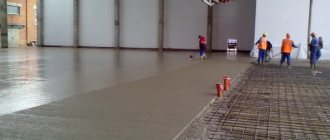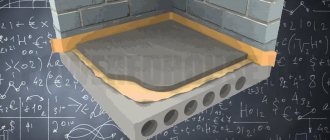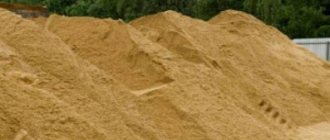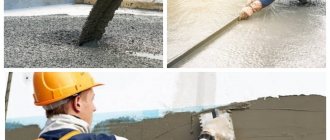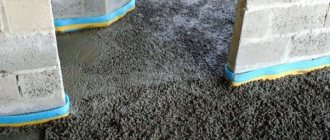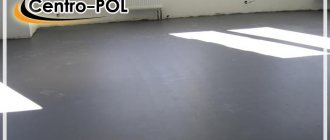What types of construction sand are there:
Several types of sand are used in the construction industry: natural origin ( quarry, river, sea ) and, to a lesser extent, artificial sand - a product of processing waste from metallurgical and other industries.
Also, the type of sand differs in the method of extraction; for example, quarry sand can be alluvial or seeded; alluvial sand makes it possible to eliminate, to a greater extent, clay inclusions that have a detrimental effect on the result.
GOSTs that must be followed when using sand:
- GOST 26633-2012 “Heavy and fine-grained concrete”;
- GOST 8736-93. “Sand for construction work”;
- GOST 5578-94. “Crushed stone and sand from slags of ferrous and non-ferrous metallurgy for concrete.”
The most harmful impurities in sand are clay, bottom silt and soil. They envelop sand particles, thereby significantly reducing their adhesion to cement. Therefore, if possible, clay, soil and silt should be completely disposed of.
Tools and equipment
Semi-dry screed is carried out using special construction equipment.
- Pneumatic compressors are professional construction equipment for supplying ready-made cement mixture for screeds to the room where work is being carried out. All the necessary components are loaded into the device, after which the automation mixes the solution and delivers it to the screed through the main pipe. Depending on the type of engine, they are divided into gasoline, diesel and electric. Such equipment is rarely purchased; more often it is rented for the duration of the work.
Pneumatic blower – professional equipment for semi-dry screed
- Absorbers are special equipment that extinguishes pressure and receives a ready-made solution from a pneumatic supercharger.
Device for laying mortar on screed
- A trowel is a device that is used to finish leveling a semi-dry screed. Thanks to this device, the likelihood of cracks appearing during drying is reduced, and it is also possible to obtain a perfectly flat surface. Screed trowels can be powered by a gasoline or electric motor.
Trowel with petrol engine
- Concrete shoes are protective pads on the feet that allow you to move along a fresh screed, leveling it.
Such soles help protect the fresh screed from damage during grouting.
- Measuring instruments - when laying semi-dry screed, you cannot do without a tape measure and level. The laser level allows you to determine the horizontal (zero level). An alternative to a laser level can be a hydraulic level, but it will require two people to operate it.
- Mason's tools - when working with semi-dry screed, tools such as trowels, grouts, etc. will be useful.
- Rule - used to distribute the solution throughout the room. Some rules have a built-in bubble level that allows you to check the correctness of the horizontal line.
Using the rule when leveling semi-dry screed
Progress of work on laying semi-dry screed
Before carrying out work on arranging the floor using the semi-dry screed method, it is necessary to properly prepare the base.
- First of all, it is necessary to collect dust and debris in the room; if there are gaps, seams or cracks in the base, they must be sealed. To do this, you can use cement-sand mortar or polyurethane foam. If there are protrusions on the surface (cement deposits, dried lumps of plaster, etc.), they must be removed. Fragile elements are knocked down with a hammer.
Preparing the base begins with cleaning the room
We suggest you familiarize yourself with: Insulation of walls under lining - Building a house
The polyurethane foam will harden faster, but after secondary expansion, some of it may be squeezed out of the seam. In this case, the excess is cut off using a construction knife.
- A deep penetration primer is applied to the surface of the base. If there are holes, large unevenness or height differences on the surface, then you can use a self-leveling mixture.
Self-leveling mixture is a special composition that is diluted to a fluid state. After this, it is applied to the surface and levels it. You can use a spatula for distribution.
- The zero level is determined using a laser or hydraulic level. It can be applied to the wall using a marker. From the zero level, use a tape measure to measure the distance to the future screed. When determining the thickness of the future screed, it is necessary to take into account not only the cement-sand layer, but also the thermal insulation layer.
When installing a laser level, you must always set it to the same height. When installing screeds throughout the apartment, it is necessary to carry out calculations in all rooms at the same level so that the floor in all rooms is at the same height. The minimum size of the screed at the highest point cannot be less than 3 cm.
In addition to polyethylene film, it is also possible to use other types of waterproofing and vapor barrier materials.
- It is necessary to glue damper tape around the perimeter of the screed. This element allows you to protect the integrity of the base from deformation during thermal expansion of the surface.
- Before installing the tape, the wall surface is also coated with a deep penetration primer. The tape is glued to the wall at separate points with a certain pitch.
The damper tape is made of foamed polyethylene. When the material is rolled up, it is cut into small pieces. You can use a hacksaw for cutting. Some types of tapes have a self-adhesive base with a protective strip.
- When the surface is prepared, you can proceed to laying the insulating material. The slab material is cut and adjusted to the length and width of the room. If it is extruded polystyrene foam, then recesses are made in it for the wires, and bulk material (sand or cement-sand mixture) is poured under the sheets for leveling. The sheets are joined to each other by lapping.
Laying slabs of extruded polystyrene foam on a backfill base
Expanded polystyrene is an easy-to-process material; it can be easily cut and trimmed using a construction knife or hacksaw.
- For reinforcement, a layer of metal mesh is laid. The material used is a rod thickness of 2 – 3 mm. Several meshes are connected to each other with an overlap of 20 cm. The mesh rods are tied together with wire.
- To mix the ingredients, auxiliary equipment (a pneumatic blower) is used; the mixture is delivered to the room via a pipeline using a damper. The solution should not flow, but when squeezed by hand it should stick together into a ball.
- The solution is distributed throughout the room using a rule. In this case, the mesh is taken out from under the solution and then trampled down. At this stage, heated floor elements are laid into the screed, if their installation is planned. The heated floor cord is secured to the reinforcing mesh with wire.
- The laser level determines the thickness of the screed. Using a construction float, beacons are made on the surface of the mortar - depressions at the level of the screed. Using the rule, the entire remaining solution is leveled using them.
Beacons for semi-dry screed are made from the mortar that is used for laying the floor
A solution is added to the places where gaps form. If excess is formed, then part of the mixture is removed.
- The surface of the screed is finally leveled using a trowel. This work must be completed within 2 hours after leveling. To avoid damaging the screed, special concrete shoes are worn on your feet.
- A day after laying the screed you can walk on it, the tiles can be laid after 72 hours. Linoleum and carpet are installed after 2 weeks. For parquet and laminate it will take 24 - 28 days. While hardening is taking place, the screed must be moistened with water in order for the process of gaining brand strength to proceed.
A semi-dry screed is a good option if you need to quickly lay the subfloor and quickly move on to creating a finishing coating. Unfortunately, this method is not without its drawbacks. The work requires a lot of experience from the master; also, for a large area, complex construction equipment will be required, and in wet rooms it is not recommended to use the semi-dry screed method at all.
More information about the types of sand used in construction work:
Career.
When extracted, such sand contains up to ten percent of various impurities. Most often it contains clay, which is not suitable for preparing concrete solutions. Therefore, only purified sand is used for the solution. For this, there is a special method for extracting quarry sand called alluvial sand; when extracted in this way, as mentioned earlier, the sand is significantly cleared of small impurities, and almost all the clay is washed out.
River.
Sand extracted from the bottom of a reservoir does not contain clay, but various stones may be present. When preparing a solution for screed from such a material, it should be stirred regularly. This is due to the fact that river sand has the ability to settle to the bottom. Often, to improve its characteristics, purified bulk material extracted from quarries is added to it.
Nautical.
This natural material is not much different from river sand. Its cost is much higher than the quarry one. This is due to the high costs of extracting sand from the seabed. The material turns out to be completely pure and practically homogeneous, with good technical characteristics. Screeds with the addition of sea sand have increased strength.
Artificial.
Mortar for pouring floors is often made from quartz sand. The material is completely clean and has high strength, which can significantly increase the quality of the floor screed. It is obtained by crushing quartz rocks. In the construction industry, artificial sand is in great demand.
Sand is suitable for screeding floors
alluvial quarry, river, sea, including artificial, but due to economic factors and the presence of a large number of mining quarries in the Moscow region, it is advisable to use quarry alluvial sand, but with one feature! Sand for semi-dry screed should be of a coarse fraction from 1.8 to 3.5 mm, so for screed we choose exactly this kind of sand from proven quarries.
The volumetric weight of quarry sand in a wet (natural) state with impurities varies in the range from 1500 to 1800 kg/m³; such sand is used during the period when the temperature outside does not drop below +5 degrees, since at low temperatures such wet sand will turn into huge ice block, fun, but working with such material is very difficult.
To work in winter, when the temperature drops to 0 and below, we use coarse-grained sand, and this sand contains a little more impurities, but as a result, the compressive strength of the screed is slightly less than when using alluvial or river sand.
Which sand is best for floor screed
For both wet and dry screed, it is best to take alluvial quarry, river or quartz sand. Do not confuse washed and alluvial sand. The first is mined using a dry open method and then washed with water. Alluvial material is obtained using special hydromechanical equipment, after first flooding the quarry. In terms of quality, it is practically not inferior to river water.
Each type has its pros and cons:
- The grains in alluvial quarry sand are not rounded, with sharp edges. They compact well and adhere to cement, which allows you to save on binder. But such a screed often shrinks. Alluvial sand is more expensive than regular sand, since it is extracted using a hydromechanical method with additional production costs.
- Particles of river sand are round, they are evenly enveloped in cement, but they are less compacted and weakly adhere to other components of the mixture. More cement is used to prepare the solution. The coating is dense and does not shrink. River sand is more expensive than quarry sand. It is not available in all regions.
- Quartz sand is fine and contains no foreign impurities. The material is quite expensive. It is often added to building mixtures. The advantage of this material is that quartz is a mineral. Unlike natural sand, it has greater strength.
Sand for concrete screed should not contain more than 1.5% clay and dust particles. Up to 1% of large inclusions (with a diameter of 5 mm or more) are allowed. The fraction should be chosen large - 2.5-3.5 mm. It gives the coating greater strength.
Ordinary quarry sand, without additional processing, is not suitable for screeding. The content of clay and dust particles in it may be higher than required by standards. In addition, the material contains large stones, pieces of clay, organic matter and simply garbage. Before use, the sand will have to be sifted and washed by hand.
The only way to use quarry sand in its pure form (provided that it contains up to 5% clay) is to construct a base under a screed. A multi-layer “pie” consisting of sand, crushed stone, waterproofing, thermal insulation and concrete screed is made in garages, bathhouses, and when laying floors on the ground.
Sand requirements for dry screed
Dry screed consists of gypsum, gypsum fiber or plywood boards laid on fine bulk material. Sand is used as a base, but there are better options. For example, expanded clay is more often used in modern dry screeds. If you have chosen sand, you need to know several features of choosing this material.
For dry screed, it is best to use quarry sand of medium or coarse fraction; it compacts well. It should not contain more than 1% of impurities with a diameter exceeding 5 mm. But clay particles are allowed up to 5%. Quartz sand is also suitable for such a coating, but due to its high price it is rarely used.
Dry screed can be installed in living rooms, on floors on the ground. She is afraid of moisture and cannot withstand heavy loads. Therefore, this coating is not suitable for the bathroom and garage.
A simple way to check the quality of sand:
To buy high-quality sand, it is not necessary to take it to a laboratory to identify foreign impurities. In a transparent container, say, a quarter of a liter glass jar is filled with sand and a quarter of water is poured, after which it is mixed well with the sand. If after 5-10 minutes the water cannot be said to be relatively transparent, then it is not recommended to use such sand for screeding.
Sand for mortar when used in industrial premises:
To install a semi-dry screed in industrial premises where the base will be subject to significant loads, you need to use only clean and high-quality sand. For such a screed, sifted sea sand of a coarse fraction from 2.5 Mk is perfect. To improve the characteristics, it is also possible to add granite screenings to the solution.
When installing a floor screed in such premises, it is recommended to carry it out with additional reinforcement with a steel frame or reinforce it with a steel road mesh with a rod thickness of at least 4 mm, or use a modern frame made of composite material.
Sand for screeding in residential premises, country houses, offices:
Sand for semi-dry screed in residential premises where there is no significant load on the base, alluvial quarry sand with a fineness modulus of 2.0 to 3.0 Mk is excellent; such sand contains minor inclusions of clay, but they will not affect the strength of the finished screed.
How much does 1m3 of sand weigh depending on the type:
Selection criteria and rules
A granular consumable for cement-sand mortar, selected in accordance with GOST standards, is the basis for a wear-resistant and durable screed for the finishing coating. The choice of raw materials is justified by the following standards:
- The composition of the bulk substance should not contain foreign impurities - materials of plant origin, limestone and clay, soil residues.
- The grain size of the bulk is medium (1.5-2.0 mm), GOST prohibits the presence of hard rocks ≥ 5 mm in size. The percentage volume of fine-grained fractions is no more than 10%.
- The uniformity of composition and color of the raw material also influence the use of sand. It should not contain pronounced dark or light inclusions of minerals. The color of the raw material usually depends on the location of the deposit. The marine source should be a solid gray color.
- The background radiation of raw materials should not exceed 370 Bq/kg for mixtures that will be installed in residential premises.
The degree of water transparency determines the possibility of using bulk raw materials.
To independently determine the quality of bulk powder of any origin, you need to pour a small volume of sand into a glass container and fill 1/3 with water, mix and wait 5-7 minutes. Find out what cement is made from at home here.
Loose filler for water floor screed
The two main components are sand and Portland cement, the mixing proportions are 2:3 with the addition of fiberglass. For 10 kg of mixture you will need up to 15 grams of additive. The finished volume of mixture for a water floor will require 4 liters of water. Next, the mixture settles for 20-30 minutes, and after that, more portions of sand, water and fiber are added to the finished solution in proportions of 20 kilograms, 4 liters, 15 grams.
The mixture is ideal for screeding water-heated floors.
Material for screeding a warm base
The mixture can be wet or semi-dry. A wet mixture is a cement-sand or concrete mortar prepared according to standard proportions; a semi-dry mixture consists of Portland cement, sand, plasticizers, and, if necessary, modifiers of the characteristics of the components. For the finishing layer, it is recommended to use self-leveling mixtures with fine additives. This working fluid easily spreads over the base, forming a uniform and level, absolutely horizontal floor. In addition, the composition for such a base should contain polypropylene and fiber fibers, which make the solution elastic and more durable. This material will tell you about the dry universal mixture M 150.
Sand for dry and semi-dry screed
The classic composition is Portland cement, water and sand, preferably washed quarry sand. For semi-dry mixtures, hydration takes place at a ratio of cement and water as 5: 1. A wet screed requires increasing the proportions - 1: 3 or 1: 2. Wet mixtures are easier to lay and level, but exceeding the volume of water can cause defects on the surface of the screed, as well as reduce the strength and wear resistance of the surface.
For semi-dry screed, water is added in minimal volumes, only to ensure that the hydration of the cement does not stop.
